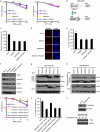hSWS1·SWSAP1 is an evolutionarily conserved complex required for efficient homologous recombination repair
- PMID: 21965664
- PMCID: PMC3308884
- DOI: 10.1074/jbc.M111.271080
hSWS1·SWSAP1 is an evolutionarily conserved complex required for efficient homologous recombination repair
Abstract
The Shu complex in yeast plays an important role in the homologous recombination pathway, which is critical for the maintenance of genomic integrity. The identification of human SWS1 (hSWS1) as the homolog of budding yeast Shu2 implicated that the Shu complex is evolutionarily conserved. However, the human counterparts of other components in this complex have not yet been identified and characterized. Here we describe the characterization of a novel human component of this complex, SWSAP1 (hSWS1-associated protein 1)/C19orf39. We show that hSWS1 and SWSAP1 form a stable complex in vivo and in vitro. hSWS1 and SWSAP1 are mutually interdependent for their stability. We further demonstrate that the purified hSWS1·SWSAP1 complex possesses single-stranded DNA-binding activity and DNA-stimulated ATPase activity. Moreover, SWSAP1 interacts with RAD51 and RAD51 paralogs, and depletion of SWSAP1 causes defects in homologous recombination repair. Thus, our results suggest that the human Shu complex (hSWS1·SWSAP1) has an evolutionarily conserved function in homologous recombination.
Figures




References
-
- van Gent D. C., Hoeijmakers J. H., Kanaar R. (2001) Nat. Rev. Genet. 2, 196–206 - PubMed
-
- Branzei D., Foiani M. (2008) Nat. Rev. Mol. Cell Biol. 9, 297–308 - PubMed
-
- Weinstock D. M., Richardson C. A., Elliott B., Jasin M. (2006) DNA Repair (Amst.) 5, 1065–1074 - PubMed
-
- Lukas J., Bartek J. (2004) Cell 118, 666–668 - PubMed
Publication types
MeSH terms
Substances
Grants and funding
LinkOut - more resources
Full Text Sources
Other Literature Sources
Molecular Biology Databases
Research Materials
Miscellaneous

